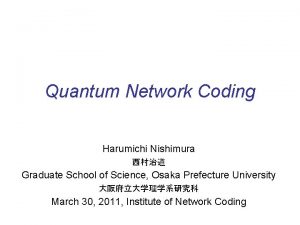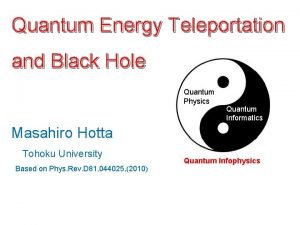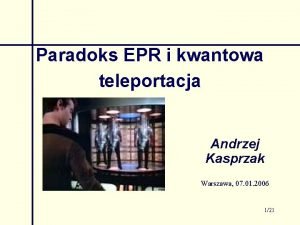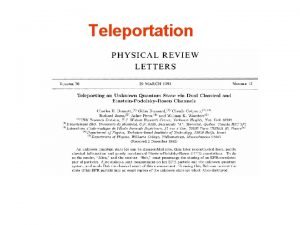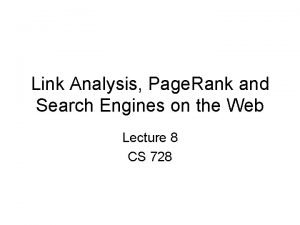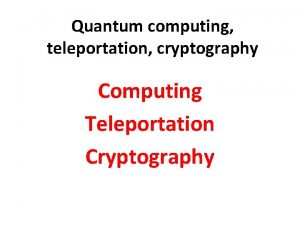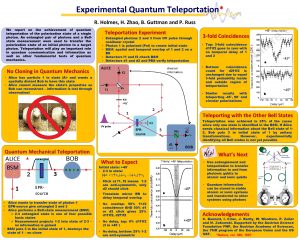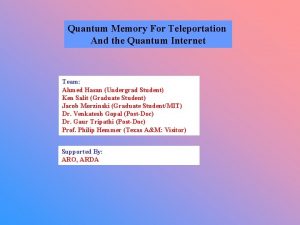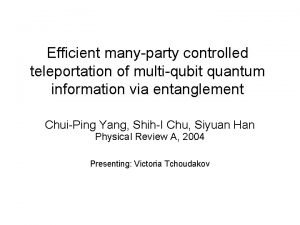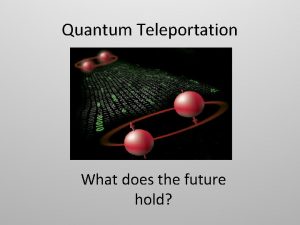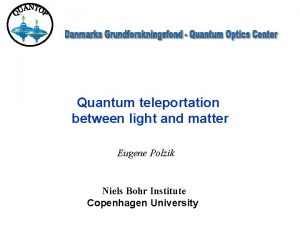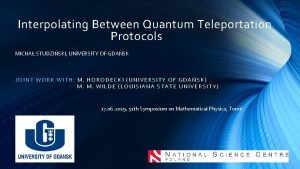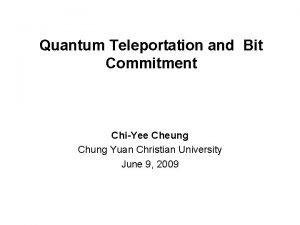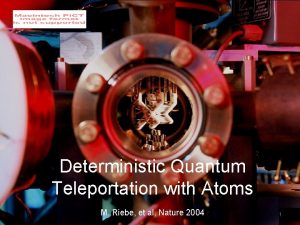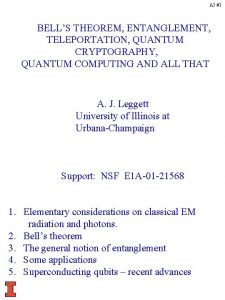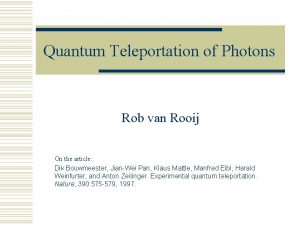Experimental Quantum Teleportation Quantum systems for Information Technology















- Slides: 15

Experimental Quantum Teleportation Quantum systems for Information Technology Kambiz Behfar Phani Kumar

Contents • Concept of Quantum Teleportation Introduction Quantum Teleportation Circuit Theoretical Results • Experimental Realization Principles Entangled States Outside Teleportation Region Inside Teleportation Region Measured Coincidence Rate Summary

Quantum Teleportation: Teleportation means: a person or object disappear while an exact replica appears in the best case immediately at some distant location. ● Bennett et al. (1993) have suggested that it is possible to transfer the quantum state of a particle onto another particle-the process of quantum teleportation-provided one does not get any information about the state in the course of this transformation. ● Application: ● Teleportation can be used in place of wiring in a large quantum computer. ● To Build a distributed system (e. g. a quantum multicomputer). and so on

Quantum Teleportation Circuit H M 1 M 2 XM 2 ZM 1

Proof

QT Circuit

Theoretical Results A complete Bell-state measurement can not only give the result that the two particles 1 and 2 are in the anti-symmetric state, but with equal probabilities of 25% we could find them in any one of the three other entangled states. After successful teleportation particle 1 is not available in its original state any more, and therefore particle 3 is not a clone but is really the result of teleportation.

Principle of Quantum Teleportation – – – – Alice has particle 1 Alice & Bob share EPR pair Alice performs BSM causing entanglement between photon 1 and 2 Alice sends classical information to Bob performs unitary transformation Teleporting the state not the particle Correlations used for data transfer Schematic idea for quantum teleportation introducing Alice as a sending and Bob as a receiving station, showing the different paths of information transfer.

Entangled States • • Type II Spontaneous Parametric down-conversion Non-linear optical process inside crystal Pulsed pump photons Creation of two polarization entangled photons 2 & 3 E 1 k(1) p = Pump k p= k(1) + k(2) E p p Ep= (2)E 1. E 2* k p k(2) E 2 Parametric down-conversion creating a signal and idler beam from the pumppulse. Energy and momentum conservation are shown on the right side.

Experimental Realization • UV pulse beam hits BBO crystal twice • Photon 1 is prepared in initial state • Photon 4 as trigger • Alice looks for coincidences • Bob knows that state is teleported and checks it. • Threefold coincidence f 1 f 2 d 1(+45°) in absence of f 1 f 2 d 2 (-45°) • Temporal overlap between photon 1, 2 Experimental set-up for quantum teleportation, showing the UV pulsed beam that creates the entangled pair, the beamsplitters and the polarisers.

Outside Teleportation Region • For distinguishable photons, with p=0. 5, 2 photons end in different O/P ports • Photon 3 polarization undefined! • So, d 1, d 2 have 50% chances of receiving photon 3 • => 25% probability for both f 1 f 2 d 1 and f 1 f 2 d 2 threefold coincidences • P(f 1 f 2 d 1) = P(f 1 f 2 d 2) = 0. 25

Inside Teleportation Region – Indistinguishable photons interfere! – Input state – If f 1, f 2 both click, then teleportation occurred and only d 1 f 1 f 2 coincidences should occur and d 2 f 1 f 2 should be 0 – Teleportation (d 1 f 1 f 2 coincidences) achieved with 25% prob.

Experimental Demonstration Theoretical and experimental threefold coincidence detection between the two Bell state detectors f 1 f 2 and one of the detectors monitoring the teleported state. Teleportation is complete when d 1 f 1 f 2 (+45°) is present in the absence of d 2 f 1 f 2(-45°) detection.

Measured Coincidence Rates

Summary • Deduced from the basic principles of quantum mechanics, it is possible to transfer the quantum state from one particle onto another over arbitrary distances. • As an experimental elaboration of that scheme we discussed the teleportation of polarization states of photons. • But quantum teleportation is not restricted to that system at all. One could imagine entangling photons with atoms or photons with ions, and so on. • Then teleportation would allow us to transfer the state of, for example, fast decohering, short-lived particles onto some more stable systems. • This opens the possibility of quantum memories, where the information of incoming photons could be stored on trapped ions, carefully shielded from the environment. • With this application we are in heart of quantum information processing.
 Quantum teleportation
Quantum teleportation Black hole teleportation
Black hole teleportation Paradoks epr
Paradoks epr Wormhole teleportation
Wormhole teleportation Bell measurements for teleportation
Bell measurements for teleportation Pagerank teleportation
Pagerank teleportation Alice bob quantum
Alice bob quantum Quantum node
Quantum node Experimental vs non experimental
Experimental vs non experimental Descriptive vs correlational vs experimental research
Descriptive vs correlational vs experimental research Disadvantages of experimental research
Disadvantages of experimental research Experimental vs nonexperimental research
Experimental vs nonexperimental research Experimental vs non experimental
Experimental vs non experimental Classical physics
Classical physics Quantum physics vs mechanics
Quantum physics vs mechanics Organizations use in conjunction with work breakdown
Organizations use in conjunction with work breakdown
